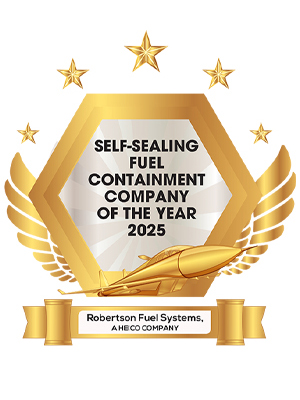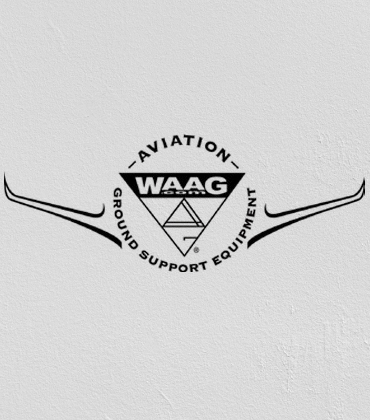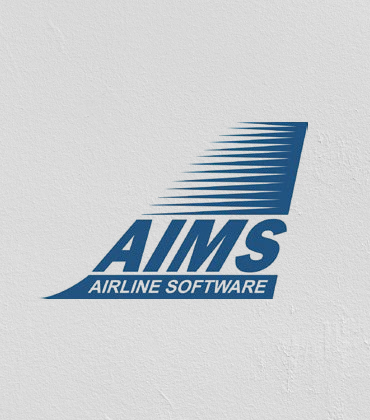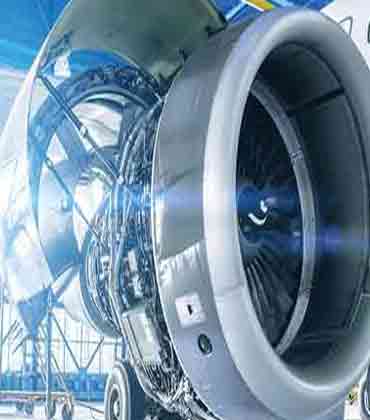THANK YOU FOR SUBSCRIBING
Nowhere is safety more crucial than in military aviation, where pilots operate in high-stakes environments that leave no room for error. A never-ending pursuit of safety, therefore, is paramount to them. Keeping this philosophy at its core, Robertson Fuel Systems — a HEICO company — has developed numerous innovative crashworthy survivable fuel systems for the military, efforts which have also yielded safer products for commercial aviation. Robertson Fuel Systems was started by Dr. S. Harry Robertson, a man who dedicated his life to researching, developing, and manufacturing safer fuel systems for military and commercial aviation. His work included conducting rigorous crash tests and drop tower experiments to understand human survivability in aircraft crashes. The crashworthy fuel system is the outcome of that research, which forms the backbone of the company’s current offerings. Its fuel tanks also incorporate self-sealing capabilities designed to withstand extreme ballistic threats, optimizing the safety and survivability of the aircraft and its crew. Even more impressive, Robertson can develop and have fuel systems flying within just 12 months, where similar programs typically take three to five years. What sets Robertson apart is its ability to rapidly develop and deploy products which meet stringent government and military survivability standards. “We provide mission commanders more than just reliable fuel solutions—we deliver fuel tanks that enhance both safety and operational success,” says Shane Openshaw, Vice President, Programs. “Our tanks are designed to ensure that even in the event of a crash, fuel remains safely contained to prevent post-incident fires.” Robertson’s fuel system solutions offer ballistic self-sealing capability ranging from 7.62mm to 23mm threats, offering a lifeline in high-risk situations. In earlier designs, a highly flammable fuel system posed a risk in the case of survivable crashes or enemy fire, but Robertson’s fuel tanks have reduced those dangers, contributing to the preservation of lives. This commitment to survivability and mission success has established the company as a trusted partner in the most demanding environments, providing clients with the safest and most dependable fuel systems. Next-level Fuel Systems Robertson offers primary and auxiliary aviation fuel systems, ground vehicle fuel systems, crashworthy fuel cells and aviation support equipment with over 60 unique system variations. These solutions are on multiple military platforms worldwide, including the AH-64 Apache, H-60 Black Hawk, H-47 Chinook, V-22 Osprey, and UH-1Y Venom. In many cases, more than one product is available for each platform, including both internal and external auxiliary fuel tank options. The aim is to provide mission commanders with maximum flexibility. For example, the Apache helicopter can carry one or two crashworthy, externally mounted auxiliary fuel tanks, each holding 125 gallons of fuel, the Combo-Pak, carrying 100 gallons of usable fuel along with some firepower, or both.
Consider the stakes of broadcasting an event like the Super Bowl or FIFA. For such highprofile events, television stations depend on uninterrupted signals as every second of lost signal translates to jeopardized contracts and millions lost in ad revenue along with viewer dissatisfaction. This is why for such events, television stations depend on satellite technology as a proven choice. Offering higher frequency and bandwidth, the satellite industry has been the backbone for broadcasting, military operations and emergency response systems for many years Carrying this legacy forward is Efficient Antenna Systems Incorporated (EASi), providing the highest standards of reliability and performance. As a global leader in satellite equipment and communication solutions, EASi ensures seamless transmission when it matters most. With stateof-the-art satellite antenna systems, some designed and manufactured in-house, the company delivers unmatched resilience. “We understand that while the industry has embraced streaming and fiber, satellite technology still provides unmatched reliability for broadcast operations and point to multi-point communication scenarios,” says Tim Hedrick, president of Efficient Antenna Systems Incorporated (EASi). “Our focus is always on delivering critical, resilient systems to meet changing market dynamics.” Frictionless Solutions, Forward-Thinking Approach EASi provides a full spectrum of solutions for all satellite communication needs from conception to completion including design, equipment procurement and project management. It offers a comprehensive range of products that includes antennas, antenna controllers, fiber systems, de-icing systems, non-penetrating mounts and electronics. In addition to product offerings, EASi specializes in services including sales, antenna set up, and programming. EASi collaborates and works closely with many manufacturing units, some that provide automated software for antenna control, optimizing every system to its peak performance. Complementing its services, the company offers both copper and fiber solutions which connect the antennas to the station’s inner infrastructure, further solidifying its reputation as a one-stop-shop. The products and solutions are designed to be versatile, offer unparalleled flexibility and can be modified to client’s specifications.
Top Aviation Ground Support Equipment Manufacturer 2025
Where efficiency, and safety are non-negotiable, ground support serves as the backbone of every successful operation. While pilots and air traffic controllers play crucial roles, the unsung heroes of ground support crews ensure that aircraft are serviced, maintained, and ready for flight. Their ability to work swiftly and safely depends on one critical factor—high-quality, wellengineered ground support equipment (GSE). That’s where WAAG, a leader in aviation ground support equipment, makes a difference. For over 15 years, WAAG has been revolutionizing the GSE industry with a distinct approach—designing stands and platforms that work across multiple aircraft. WAAG’s GSE products are durable and reliable, giving clients the confidence to build high-performing teams that excel in ground support operations. “Our industry-leading GSE products are unparalleled in quality and design, and our dedication to customer satisfaction is second to none,” says Mike Calka, president of WAAG. WAAG has developed a line of lightweight, ergonomic adjustable height stands that eliminates the need for hydraulic cylinders, instead using a spring-loaded mechanism to reduce weight. The equipment features Heavy-duty innovative KPL casters with precision bearings for swift towing, easy maneuverability, and non-slip grip-strut platforms to maximize stability. Single-action plunge brakes easily engage, ensuring each stand stays firmly in place during use. Each unit is finished with a base color coat and a super durable clear coat, for longlasting protection against harsh environmental conditions. WAAG’s product line serves a diverse range of clients, including service companies, Air Force, and commercial airlines. Its equipment is trusted by professionals servicing a wide range of aircraft. The adaptability of WAAG’s stands allows airlines to standardize their equipment while maintaining the flexibility needed to service multiple aircraft models with the least amount of equipment. The company also produces heavy-duty tire racks designed to withstand daily wear and tear in demanding conditions. WAAG’s “signature design” modular tire racks, offer various options necessary to meet tire size and quantity requirements.
Top Flight Operations System 2025
Managing airline operations is a dynamic and complex process that requires precision and efficiency. From planning flight schedules to handling crew assignments and ensuring compliance with stringent aviation regulations, airlines are constantly optimizing their operations to meet evolving demands. Turning operations into opportunities for growth requires more than just the right tools—it demands a trusted partner with deep industry expertise. AIMS Airline Software delivers an all-in-one solution designed specifically for the complexities of modern aviation. By empowering airlines to streamline operations, reduce costs, and maximize efficiency, the company helps its clients stay agile, competitive, and ready to meet the industry’s evolving demands. Effortless Crew Management and Real-Time Updates The team at AIMS Airline Software has a deep understanding of the aviation industry and recognizes that creating flight schedules for the upcoming season is a complex balancing act. Airlines must align operational capacity with passenger demand while also managing aircraft schedules, ensuring planes are available and properly maintained, and avoiding conflicts. Perhaps the most challenging aspect is crew scheduling—managing hundreds or even thousands of employees while adhering to strict regulations set by authorities like the Federal Aviation Administration (FAA) and the Civil Aviation Authority (CAA). These regulations govern flight time limitations and mandatory rest periods, making compliance non-negotiable. “We simplify these processes by offering an intuitive platform that automates scheduling and checks for regulatory compliance in real time. This ensures airlines can generate legal schedules without the risk of human error,” says Glen Bethanis, MD and Head of Strategic Planning at AIMS Airline Software. For crew management, AIMS Airline Software tracks everything from flight hours to mandatory training and vacation requests. It provides a self-service portal that allows crew members to request vacations, bid for schedules, and receive real-time updates through mobile notifications. Crew members can also view their assigned instructors, flight details, and fellow crew members—all from their mobile devices. In addition to crew management, the company offers tools to handle hotel and travel arrangements. Its engine calculates the number of rooms needed and arranges travel logistics, ensuring that crew members are accommodated throughout their assignments. These features dramatically reduce manual work and help airlines save both time and money by minimizing delays and improving overall efficiency. AIMS Airline Software also automates expense tracking, simplifying the reimbursement process for crew members and helping airlines maintain better cost control. A Trusted Partner in Modern Aviation Many of AIMS Airline Software’s clients initially relied on Excel-based processes or less advanced software that failed to scale as their operations grew. The company plays a crucial role in helping airlines transition from outdated systems to scalable, next-generation solutions.
CXO INSIGHTS

Supporting Sustainability in Aviation
Bonny Simi, President of Operations, Joby Aviation(NYSE: JOBY)

Airport Management Innovations: Navigating Challenges Effectively
Abe Weber, Airport Director, Appleton International Airport

Realizing Responsive Space
Bill Doyle, Senior Director of Satellite Program Management, Loft Orbital

Strategies for Success and Safety in a Thriving Airline Industry
Alfonso Moreno-Santa, Director of Operations, PrimeFlight

Strategic Leadership In Aviation Fuel Management
Joe Burrows, Director of Fuel Operations, Southwest Airlines (NYSE: LUV)
IN FOCUS
EDITORIAL
Satellites Reshaping Modern Aviation
Aviation thrives on accuracy and efficiency, with airlines ensuring safe, timely, and fuel-conscious travel for millions of passengers daily. Advanced satellite technology has transformed air navigation and communication, enhancing operational efficiency and making air travel more reliable and secure. Satellites are now the unseen force shaping modern aviation, powering everything from in-flight connectivity and passenger entertainment to real-time analytics that refine flight paths and cut fuel consumption. These systems create a seamless data flow between aircraft and ground stations, equipping pilots and air traffic controllers with precise, real-time insights to enhance safety and efficiency. With satellite-driven navigation and air traffic management, airlines optimize routes, minimize delays, and reduce environmental impact through lower emissions. Beyond commercial aviation, satellite technology is pivotal in defense, supporting mission-critical operations such as intelligence gathering, secure data transmission, and strategic coordination. These advancements have expanded global coverage and predictive analytics, strengthening military and civilian aviation. AI-driven satellite applications are taking this further, enabling real-time flight monitoring, predictive maintenance, and space-based air traffic management systems. However, upgrading infrastructure, aligning international regulations, and tackling cybersecurity threats are essential as data moves freely between terrestrial and space-based networks. Aviation is evolving into a more interconnected and data-driven industry, unlocking new business opportunities and cross-sector collaborations that will shape the future of safer, smarter air travel. In this edition, we feature several influential companies that have blazed a trail in these markets. Robertson Fuel Systems, a HEICO company specializes in life-saving fuel containment solutions for military and commercial aircraft and vehicles. We also feature insights from Eric Hein, Vice President - Defense Programs at Spirit AeroSystems, and Ross Peterson, Director of Engineering and Reliability at Piedmont Airlines. We hope these expert insights from industry leaders will assist you in making informed decisions for your businesses.

However, if you would like to share the information in this article, you may use the link below:
https://www.aerospacedefenserevieweurope.com/edition/may-2025-25.html












